|
Displaying items by tag: Will Barnet
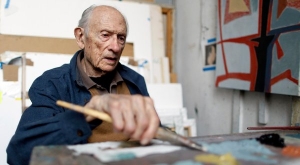
A printmaker and painter, there is a quiet, striking quality that pervades all of Will Barnet’s art. Best known for his portraits of women, children, animals, family members, and friends, Barnet passed away at his home in Manhattan on November 13. He has lived at the National Arts Club building on New York City’s Gramercy Park since 1982. Barnet was 101.
A native of Beverly, Massachusetts, Barnet studied at the School of the Museum of Fine Arts, Boston and then, starting in 1931, at the Arts Students League in New York. It was here that Barnet studied briefly with the early Modernist painter Stuart Davis and became acquainted with Arshile Gorky, a major influence on Abstract Expressionism. Four years after joining the League, Barnet was named the official printer and went on to work for the Works Progress Administration Federal Art Project. He also made prints for well-known artists such as the Mexican muralist Jose Clemente Orozco and the painter and cartoonist William Gropper.
Barnet started out as a Social Realist printmaker and had his first solo exhibition in 1935 at the Eighth Street Playhouse in Manhattan. Three years later, he had his first gallery show at the Hudson Walker Gallery. It was during this time that he married Mary Sinclair, a painter and fellow student. They had three sons.
In the 1940s Barnet was inspired by Modernist inclinations and his paintings became more colorful and fractured, depicting family scenes and young children. By the end of the decade Barnet moved towards complete abstraction after becoming involved with the Indian Space Painters, a group that created abstract paintings using forms from Native American art and modern European painting.
In the 1950s Barnet divorced Sinclair and remarried Elena Ciurlys with whom he had a daughter. It wasn’t until the 1960s that Barnet returned to representational painting, often using his wife and daughter as subjects. Barnet’s style had evolved and the portraits from this time are flatter and more exact. He also made a number of portraits of the architect Frederick Kiesler, the art critic Katherine Kuh, and the art collector Roy Neuberger during this time.
Barnet never stopped painting and continued to experiment and evolve stylistically, returning to abstraction in 2003. In 2010 he was the subject of the exhibition Will Barnet and the Art Students League at the Phyllis Harriman Mason Gallery in Manhattan. He was awarded a National Medal of Arts in 2011, which he accepted from President Obama at a ceremony at the White House. The subject of many museum retrospectives, Will Barnet at 100, which took place at the National Academy Museum in 2011, was the last.
Besides his work as an artist, Barnet was also an influential instructor. He taught graphic arts and composition at the Art Students League in 1936 and went on to teach painting at the school until 1980. Barnet also taught at Cooper Union from 1945 to 1978 and briefly at Yale, the Pennsylvania Academy of Fine Arts, and other schools.
Barnet is survived by his wife, three sons, one daughter, nine grandchildren, and three great-grandchildren.
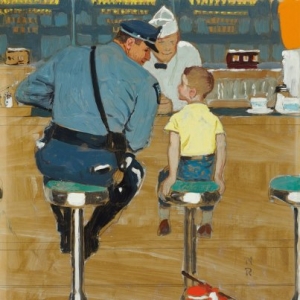
Held in New York on September 25th, Christie’s American Art sale counted two Norman Rockwell works on paper as the top lots. Study for ‘The Runaway,’ perhaps the artist’s most iconic image, brought in $206,500. The original estimate for Study at auction was $80,000–$120,000. In 1958, the completed work, which features a young boy at a diner in conversation with a policeman, was used as a Saturday Evening Post cover.
The other Rockwell that fared well was Keeping His Course (Exeter Grill) which had an estimate of $100,000 to $150,000 and ended up selling for $218,500. The work was originally conceived as an illustration for the book Keeping His Course (1918) by Ralph Henry Barbour. A less recognizable Rockwell, A Man’s Wife, didn’t quite reach it’s $30,000–$50,000 estimate and ending up selling for $27,500.
Edgar Alwin Payne’s Western painting La Marque Lake, High Sierra more than doubled its $25,000–$35,000 estimate when it sold for $80,500. Other works that exceeded expectations were Andrew Wyeth’s watercolor, Front Door at Teel’s (estimate: $50,000–$70,000), that realized $93,700 and Josef Mario Korbel’s Andante (Dancing Girls) (estimate: $30,000–$50,000), a bronze that brought in $62,500.
The auction offered over 160 lots including Impressionist and Modernist works, Western pieces, illustrations, and bronzes. Artists on the block included Stuart Davis, Milton Avery, Will Barnet, Edward Hopper, and William Merritt Chase. Expected to reach in excess of $2.5 million, the total sale realized for the auction was $2,649,475.
While the auction reached its estimate, only 63% sold by lot and 76% by value. Debra Force of Debra Force Fine Art, Inc. said, “63% is terrible but there are many reasons for the poor performance. September is too early in the season for a sale. People are just getting back from summer, putting kids in school, and it’s in the middle of the Jewish holidays.” Force added, “The important collectors don’t look at these mid-season sales. They should, but they’re waiting for the major sale.“
Gavin Spanierman of Gavin Spanierman Ltd. echoed Force’s sentiments. “63% is pretty scary if you’re a seller but that’s representative of mid-season sales. However, the fact that the two Rockwells did well considering they were not phenomenal, shows that there is strength in the market.”
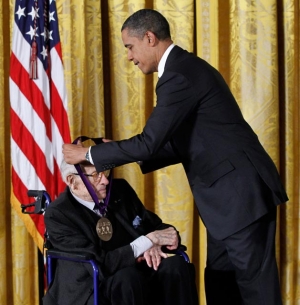
Painter and printmaker Will Barnet received one of the country's highest honors Monday when President Obama presented him with a National Medal of Arts.
Barnet, 100, has deep Maine ties. Much of the inspiration for his artistic vision derives from his time in Maine, particularly in and around the midcoast area of Phippsburg.
Barnet, who lives in New York most of the year, received his medal in an East Room ceremony at the White House.
The White House cited Barnet "for his contributions as an American painter, printmaker and teacher. His nuanced and graceful depictions of family and personal scenes, for which he is best known, are meticulously constructed of flat planes that reveal a lifelong exploration of abstraction, expressionism and geometry. For more than 80 years, Mr. Barnet has been a constant force in the visual arts world, marrying sophistication and emotion with beauty and form."
Among others who received honors Monday were actor Al Pacino, country music great Mel Tillis and pianist Andre Watts.
In remarks before conferring the medals, Obama praised artists for their contributions to society, and characterized those honored as "icons" for their courage to "dwell in possibilities."
"As much as we need engineers and scientists," the president said, "we also need artists and scholars ... to disrupt our views and challenge our assumptions."
Susan Danly, senior curator at the Portland Museum of Art, said the museum has 13 Barnet images in its collection, though none is currently on view.
"We are very proud of him," Danly said.
"This is a top honor bestowed on an artist in the country, and certainly Will Barnet is one of the pre-eminent painters in Maine today. He has a longstanding love of New England and of Maine."
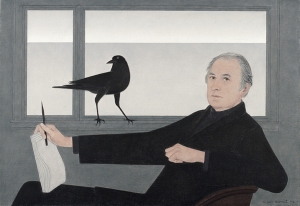
One-hundred years in the making, Will Barnet at 100 – the artist’s first New York museum retrospective – will open at the National Academy Museum on September 16, 2011 and continue through December 31.
Barnet has work in virtually every major museum in the United States, and his figurative and abstract paintings and prints continue to advance the fine arts. During a career that has spanned over 80 years, Barnet has been a printer for major artists, including Louise Bourgeois, a teacher of Eva Hesse, James Rosenquist, and Tom Wesselmann, and he remains a colleague and source of inspiration to hundreds of artists, curators, and collectors.
A member of the National Academy since 1982, Barnet lives in New York City and celebrated his 100th birthday on May 25, 2011.
Will Barnet at 100 will include 43 paintings and prints that range in date from 1935 – five years after he moved from Beverly, MA to New York City at age 19 – through 2008. The loan exhibition, which includes works from numerous public and private collections, is organized by Bruce Weber, Senior Curator, Nineteenth and Early Twentieth Century Art, National Academy Museum, and will be accompanied by an illustrated catalogue.
In related programming, the museum will host Will Barnet in Conversation on October 12, 2011, when Barnet will join Weber in a discussion of the retrospective and his career, and Will Barnet at 100 – A Symposium on November 5. The day-long symposium will include a series of lectures by art historians on different aspects of Barnet’s life and work, as well as a panel discussion including artist Philip Pearlstein that will illuminate Barnet’s place within the context of American art.
The retrospective, talk, and symposium are among the National Academy Museum’s reopening events after being closed for renovation since July 2010.
Barnet was born in Beverly, MA in 1911. He moved to New York in 1930 and embarked on an 80-year career as an artist, printmaker, and instructor. Barnet taught at the Art Students League (1941-1979) and Cooper Union (1945-1967) in New York and at the Pennsylvania Academy of the Fine Arts (1967-1992) in addition to shorter term appointments. He also continues to conduct workshops and critiques at the National Academy School, which he has done since 2001.
The works in the exhibition trace Barnet’s explorations of figuration and abstraction, including WPA-tinted realism, Hard-Edged abstraction, and Indian Space painting, with its fields of color and imagery inspired by indigenous art of North and South America. An impassioned student of the visual arts of many cultures, Barnet’s investigations have been informed by old and modern masters, Byzantine art, Hopi bowls, geometric patterns found in ancient Peruvian textiles, and American folk art.
The arc of Barnet’s work runs from realism in the 1930s, when he worked primarily as a graphic artist and printer, to increasingly abstract work in the 1940s, full abstraction in the 1950s and early 1960s, and a figurative style in the 1960s through 2003, when he returned to abstraction.
Highlights of the exhibition include Idle Hands, from 1935, in which a deflated man is seated, his elbows resting on his knees and arms crossed as his torso slumps forward. With a cap covering his downcast face, the figure illuminates the Depression-era plight of millions of people unable to find work.
By 1946, when Barnet completed Soft Boiled Eggs, he had entered the realm of Modernism. In the painting, Barnet’s wife and three children surround a kitchen table. In sharp contrast to Idle Hands, all of the flatly rendered elements in the painting are brought to the foreground without any hint of depth or pictorial illusion.
The 1959 Singular Image is a purely abstract work “prompted by a glimpse of his shadow as it intersected cracks in a city sidewalk,” as Weber notes in the exhibition catalogue, Will Barnet at 100. Barnet has explained that the cross-like form outlined in white and floating against a dark background expresses “the idea of modern man being … pushed in by all kinds of forces.”
In the early ‘60s, Barnet returned to figuration in paintings of his family, friends, and associates. The 1972 painting, Woman and the Sea, was inspired by a moment when he saw the silhouetted figure of his second wife, Elena, leaning against a porch column in a summer house in Maine and looking out across the ocean. As Weber notes in his catalogue essay, “The picture alludes to New England days of the past and the countless women left behind by men who went to sea… For Barnet, the woman was a universal symbol of strength, home, and endurance in the face of life’s mysteries.”
In 2003, Barnet returned to abstraction to explore form, space, and color anew. Strolling, from 2008, has a lighter palette and freer and more open sense of composition than many of his earlier abstract works.
Founded in 1825, the National Academy Museum and School is the only institution of its kind that integrates a museum, art school, and honorary association of artists and architects dedicated to creating and preserving a living history of American art. The Academy promotes American art and architecture through exhibition and education and continues to play a critical role in fostering the visual arts in America.
Exhibition: Will Barnet at 100
Dates: September 16 – December 31, 2011
Hours: Wednesday – Sunday, 11:00 AM – 6:00 PM
Note: Closed July 4th, Thanksgiving, Christmas Day and New Year’s Day
Discussion: Will Barnet in Conversation
Date: October 12, 2011
Time: 6:45 PM
Symposium: Will Barnet at 100 – A Symposium
Date: November 5, 2011
Hours: 9:30 AM – 5:00 PM
Location: National Academy Museum, 1083 Fifth Avenue, 89th/90th Streets
Admission: Adults: $12; Seniors (65+) and students with valid ID: $7
Children, members, and students of the National Academy School: free
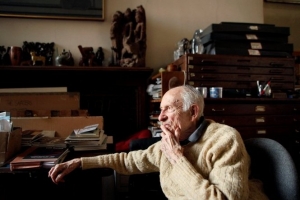
Will Barnet, who turns 100 in May, hurt his leg in a fall some time ago and nowadays does his "walking" in a wheeled office chair.
Every month or so, his son, Peter, now 72 and head of the painting department at Montclair State University, brings Dad to the Metropolitan or another big museum and pushes him through the galleries in his wheelchair.
Of course, Barnet loves art. He was a teacher at the Art Students League for 45 years and has been a well-known painter and printmaker for over 70 years, with an encyclopedic knowledge of American art and artists.
But even at his advanced age, Barnet is more than just an enthusiast. As shown in his "Centennial Celebration" — an exhibit of 10 paintings from the past year currently on display at the Montclair Art Museum — Barnet is still bringing the canvas to life himself.
"When I have an idea I go investigate it," Barnet says under the wall-sized window of his studio at the National Arts Club, where he has lived for 35 years. "I had been casting around for an animal to replace the cats in my work, and I thought I might try crows."
He’d gone to a crow hospital, where injured crows are nursed back to health, in order to study them. "Did you know Maine crows are different from other crows? They are. They have longer legs, and more streamlined bodies."
|
|
|
|
|